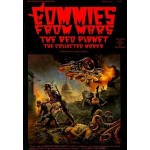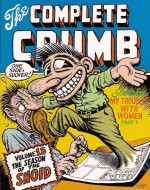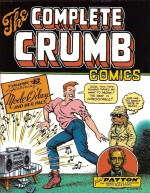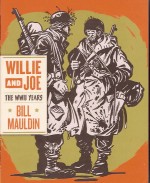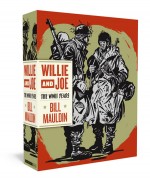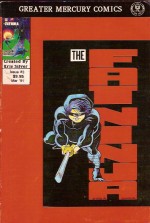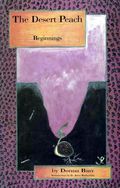
By Donna Barr (Mu-Aeon/Atlantic Books)
Aeon no ISBN, Atlantic ISBN: 978-1-88384-713-5
In Acknowledgement of the upcoming Comics in Conflict event at the Imperial War Museum this weekend – see our Noticeboard for details – I’m going to be reviewing a few intriguing and hopefully pertinent classics beginning with this criminally neglected comics gem…
Donna Barr is one of the comic world’s most unique talents. She has constructed a fully realised fantasyscape to house her stories and tells them with a style and voice that are definitely one-of-a-kind.
Her most well known creations are Stinz Löwhard, the Half-Horse and the star of this particular volume, Pfirsich Rommel the outrageously out, homosexual brother of the legendary perfect German soldier dubbed “The Desert Foxâ€.
The stories are set in World War II Africa and effortlessly combine hilarity, surreality profound sensitivity and glittering spontaneity.
Oberst Manfred Pfirsich Marie Rommel, like his Field Marshal brother Erwin, was part of the German invasion force in from 1940-1943. However, although as capable as his elder sibling, the gracious and convivial Desert Peach was a man who loathed harming anybody physically or emotionally and thus spent his days with the ever-so-motley crew of the 469th Halftrack, Gravedigging & Support Unit of the Afrika Korps. trying to remain stylish, elegant and non-threatening to the men under his command, the natives and the rather trying British – not all of whom were party to the clandestine non-aggression pact he had made with his opposite numbers in the amassed Allied Forces…
Pfirsich was also wildly in love with Rosen Kavalier: manly Luftwaffe ace and the Peach’s fiancé…
The Desert Peach ran for 32 intermittent issues from a number of publishers and was subsequently collected as eight graphic novel collections between 1988-2005, with a prose novel – Bread and Swans, a musical and an invitational collection by other artists entitled Ersatz Peach. A larger compendium, Seven Peaches, collects issues #1-7 and Pfirsich’s further exploits continue as part of the Modern Tales webcomics collective…
However, this hard-to-find first softcover collection reprints issues #1-3, opening with ‘Who is This Man?‘ as Pfirsich inspects his tiresomely peculiar band of maverick military men (the 469th is where the real army transfers its problem cases) prior to losing a map crucial to the German army’s advance. Not that the Peach is particularly upset over the military ramifications… he just doesn’t want to get his beloved brother into trouble…
And of course that’s the very moment Erwin pops over for a visit…
The real star of these fabulous comedy epics is the Peach’s long-suffering, unkempt, crafty, ill-mannered, bilious and lazily scrofulous orderly Udo Schmidt, whose one redeeming virtue is his uncompromising loyalty and devotion to the only decent officer in the army. As the broad and cunning farce unfolds the lost map leads inevitably to a confrontation with a bunch of British soldiers unaware of the unofficial truce, who then make the inexcusable gaffe of opening fire on Pfirsich and his desperately distressed subordinates.
Big mistake…
This first captivating excursion is capped off with a magical extra: cut-out paper-dolls of Pfirsich’s personal pilot von Drachenberg (whose plane is not, Not, NOT painted Pink, but actually a delightful shade of Peach) and his assorted uniform clothes…
In #2 after a gloriously experimental fourth-wall busting scratchboard sequence the military merriment continues unabated in ‘The Bar Fight’ as the urbane and generally peaceable Peach is provoked beyond all human endurance by a homosexual-hating Russian at the enlisted men’s unsanctioned watering hole…
Barr herself is ex-military and a devoted researcher in love with the often paradoxical minutiae of the martial life, so her scripts are rife with daft but true facts and circumstances, all utilised to enhance her brilliant tales, such as the knowledge that anti-communist Don Cossacks were allies of the Wehrmacht. One such, ultra-macho Semyon Bryonovich Givsonov, learns here to his temporary regret and eternal gratitude that some “fancy-boys†have a temper when pushed too far…
This spectacular boozy, bottle-busting battle yarn is followed by an utterly off-the-wall and indescribable exploit which nevertheless hangs together perfectly as Pfirsich commandeers Brother Erwin’s search for Allied submarines off the African coast to teach the Desert Fox the finer points of surfing in ‘A Day at the Beach’.
It doesn’t start too well but things quickly shape up once the work-shy Udo accidentally captures an American soldier from Hawaii who is convinced to give the gathered troops a few tips…
One note of warning for the usually squeamish hetero male readership: bathing suits were not standard issue for German soldiers during WWII so if exposed – but historically accurate – military buttockry is apt to unsettle, you might want to turn these pages carefully – although bluff old straight me personally found the Peach’s non-regulation swimsuit of svelte diaphanous pink (sorry, peach) ruffles a far more distracting notion…
Barr’s work is distinctive and honest but not to everybody’s taste, which is a shame as she has lots to say and a truly wondrous way of saying it.
Referencing the same vast story potential as Sgt. Bilko, Hogan’s Heroes, Oh, What a Lovely War! and even a little bit of Catch 22, the Desert Peach is bawdy, raucous, clever, authentically madcap and immensely engaging. These first tentative tastes of the fruits of combat were some of the very best comic tales of the 1980s and 1990s and still pack the comedic punch of a chartreuse howitzer, liberally leavened with situational jocularity, accent humour and lots of footnoted Deutsche cuss-words for the kids to learn.
Illustrated in Barr’s fluidly seductive wood-cut and loose-line style this book is a must-have for any history-loving, war-hating fun seeker and comes with an added attraction.
‘Ratzen’, scripted and drawn by Chuck Melville, is a clever vignette in which the assorted vermin of the 469th fall out over the definition of what is and isn’t a pet…
Beginnings and the 1998 reissue are pretty scarce these days but if you have a Kindle Robot Comics have just begun to release the individual comicbook issues for anybody who can get the hang of all this verfluchte new technology…
© 1988-1989, 1995 Donna Barr. Introduction © 1995 D. Aviva Rothschild. “Ratzen†© 1995 Chuck Melville. All rights reserved.



